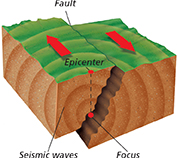Earthquakes and Seismic Waves
The buildup of stress along a fault provides the energy that powers an earthquake.  Earthquakes occur because stress forces have exceeded the strength of rock.
Earthquakes occur because stress forces have exceeded the strength of rock.
As you can see in Figure 35, the location beneath Earth's surface where an earthquake begins is called the focus (also known as the hypocenter). The location on Earth's surface directly above the focus is called the epicenter (EHP uh sen tur). As an earthquake occurs, seismic waves move out in all directions from the focus.
Figure 35 When an earthquake occurs on a fault, seismic waves move out from the focus. The epicenter lies on the surface, directly above the focus.

The Physics of Earthquakes
Within Earth's crust, forces are at work along faults. They cause the two sides of a fault to move past each other. Sometimes the rocks along the two sides of a fault may snag and remain locked because of friction between the two fault surfaces. As a result, tremendous stress builds up in these areas.
Any material has a limit to how much stress it can absorb. When rocks are strained beyond their limit, they break and grind past each other, releasing huge amounts of energy in the form of an earthquake. As the rocks break and move, potential energy is transformed into kinetic energy in the form of seismic waves.
Types of Seismic Waves
Earthquakes produce three main types of seismic waves: P waves, S waves, and surface waves. Each type of seismic wave has different characteristics.
P waves (originally called primary waves) are longitudinal waves similar to sound waves. Recall that, as longitudinal waves move through a material, they cause particles in the material to vibrate in the direction of the waves' motion. Thus, P waves compress and expand the ground like an accordion, as you can see in Figure 36. Because P waves are the fastest seismic waves, they are the first to be detected at a distance. P waves can travel through both solids and liquids.
Figure 36 P waves and S waves are seismic waves that travel through Earth's interior. P waves are longitudinal waves that compress and expand the ground. S waves are transverse waves in which particles vibrate at right angles to the waves' direction of movement.
 d
d



